
Fashion brands operate in a fast-paced environment where inventory management and product development must align perfectly. Efficient stock control, quick lead times, and high-quality products are non-negotiable for success. To manage these processes, brands typically choose between Product Lifecycle Management (PLM) software and standalone inventory management software.
Understanding the differences between these tools can help fashion businesses make the right choice. This article dives into the core functions of each and explains why an integrated solution often provides the best results for growing brands.
What Is Inventory Management Software?
Inventory management software focuses solely on tracking and controlling stock. It ensures businesses have accurate insights into inventory levels and can manage their supply effectively.
Key features of standalone inventory management software include:
1. Stock Control
At its core, inventory software tracks stock levels for raw materials, work-in-progress items, and finished goods. This helps businesses avoid stockouts and overstocking, ensuring the right balance.
2. Purchase Orders
This software automates purchase order creation, tracking supplier orders and ensuring timely replenishment of stock.
3. Lead Time Management
Lead times, the time between ordering and receiving stock, are critical in fashion. Inventory software monitors this, helping businesses plan better.
4. Point of Sale Integration
Many inventory systems sync with point-of-sale (POS) tools, giving real-time updates on stock sold in retail locations. This ensures accurate inventory records and simplifies stock control.
5. Multiple Warehouse Management
Fashion brands often operate across multiple warehouses. Inventory management software provides visibility into stock levels at each location, streamlining transfers and fulfillment.
These features make standalone inventory systems ideal for managing stock efficiently. Many solutions are also cloud-based, allowing real-time data access from anywhere. This is especially useful for small businesses or startups managing their operations remotely.
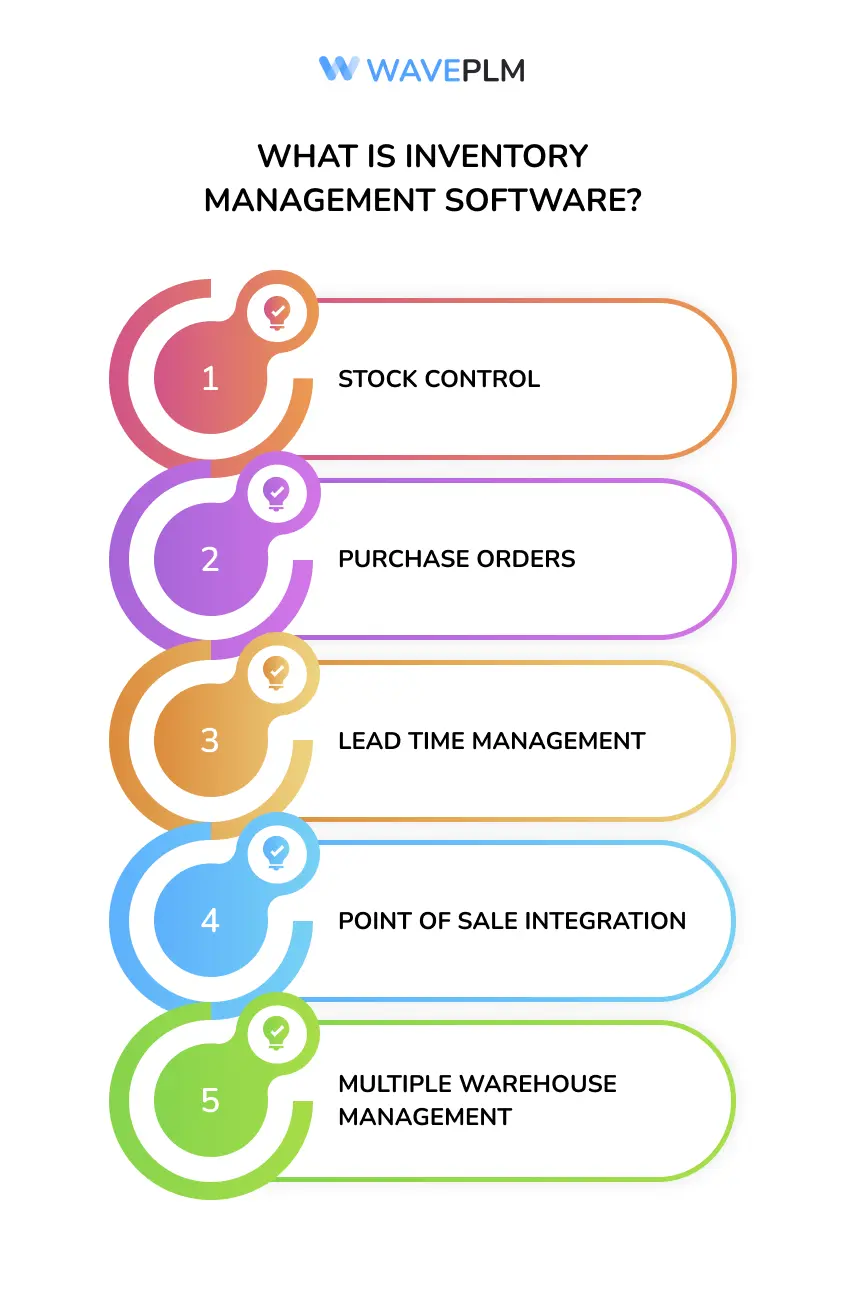
What Is PLM Software?
PLM software provides a broader solution, managing the entire lifecycle of a product. From the initial concept to final delivery, PLM tracks every stage.
Key functions of PLM include:
1. Product Design and Development
PLM supports design and development by centralizing product data. Designers, developers, and production teams can collaborate easily, reducing errors and improving product quality.
2. Quality Management
Maintaining quality is essential for fashion brands. PLM integrates quality control into every stage, ensuring consistent standards from the first sample to the final product.
3. Manufacturing Process Management
PLM links design data directly to production teams. This ensures smooth transitions from design to manufacturing, reducing delays and improving efficiency.
4. Customer Service Improvements
With centralized product data, customer service teams can access the information they need to resolve issues quickly. This improves customer satisfaction and loyalty.
5. Cloud-Based Collaboration
PLM systems are typically cloud-based, allowing teams across different locations to collaborate in real-time. This is especially beneficial for brands with global operations.
PLM offers a comprehensive solution that connects all departments involved in bringing a product to market. It’s ideal for fashion brands managing complex processes, from design to distribution.
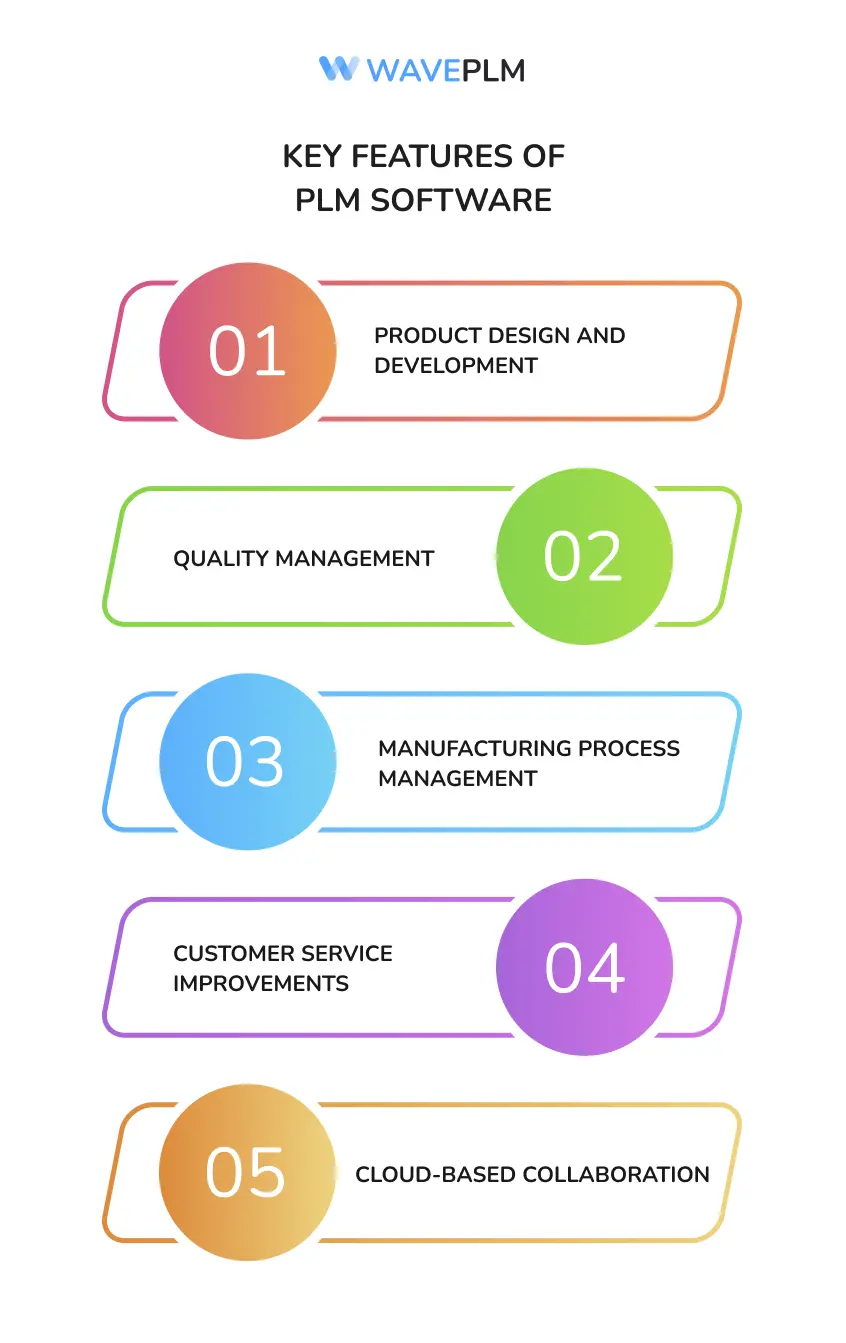
Key Differences Between PLM and Inventory Management Software
Both PLM and inventory management software offer valuable tools, but their focus and functionality differ significantly. Here’s a closer look at how they compare:
1. Scope and Functionality
- Inventory management software focuses solely on stock control and related processes like purchase orders and lead times.
- PLM software handles the entire product lifecycle, including design, production, quality control, and distribution.
For businesses needing more than just stock tracking, PLM provides a more comprehensive solution.
2. Integration with Business Processes
Standalone inventory systems often integrate with POS and accounting software, offering basic connections to sales and financial data.
PLM integrates with all major business processes, connecting departments like design, production, and logistics. This integration ensures smooth workflows and better communication between teams.
3. Scalability
Inventory management systems work well for small businesses or those with limited product lines. They are easy to set up and use, making them a good fit for businesses just starting.
PLM software scales with your business. As you add more products, expand to multiple warehouses, or grow your team, PLM can handle the increased complexity.
4. Lead Time Reduction
Both systems help reduce lead times but in different ways.
- Inventory software focuses on efficient stock management and timely reordering.
- PLM software streamlines the entire development and manufacturing process, reducing delays from design to delivery.
This makes PLM especially valuable for fashion brands looking to speed up time-to-market.
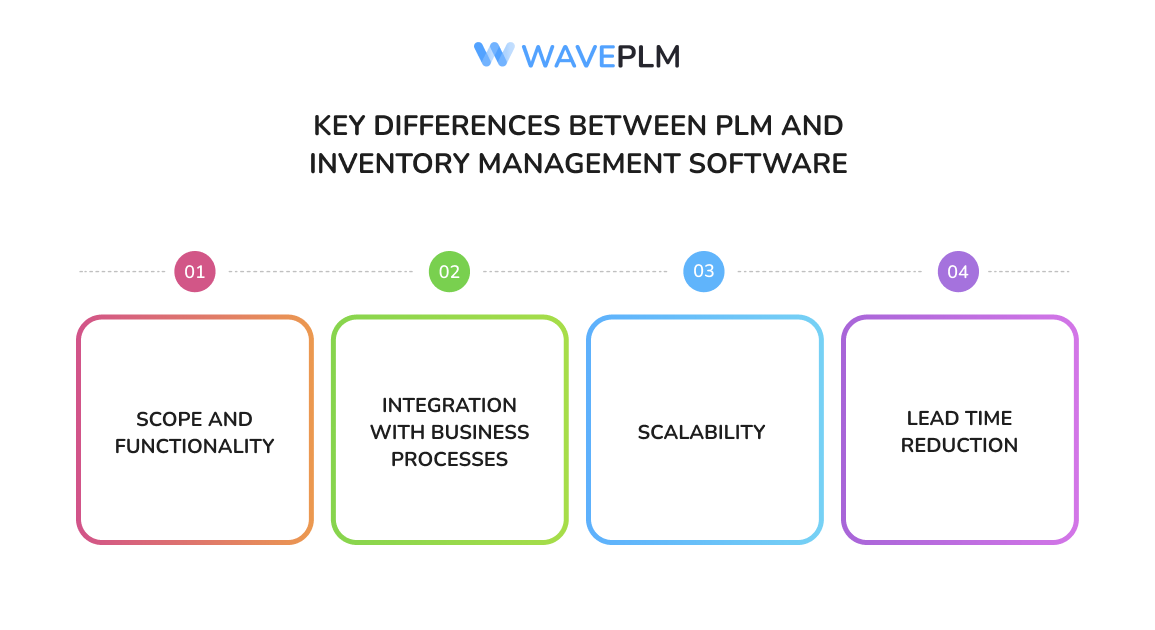
Why Fashion Brands Should Consider PLM
Fashion supply chains are intricate, involving numerous steps from design to distribution. PLM software helps manage these complexities and offers several key advantages:
1. Improved Collaboration Across Teams
In fashion, collaboration between design, production, and logistics teams is critical. PLM centralizes data and provides tools for real-time communication, ensuring everyone works from the same information. This reduces errors and improves decision-making.
2. Enhanced Quality Control
Quality is a major differentiator in fashion. PLM embeds quality checks at every stage, ensuring that only the best products reach customers. By catching defects early, brands can avoid costly recalls and maintain their reputation.
3. End-to-End Visibility
With PLM, fashion brands gain complete visibility into their supply chain. They can monitor every step, from raw material sourcing to finished goods distribution. This helps identify inefficiencies and optimize workflows.
4. Faster Time to Market
Fashion trends change rapidly, and brands need to adapt quickly. PLM speeds up product development cycles, helping businesses launch new collections faster. This allows them to stay ahead of trends and meet customer demand more effectively.
5. Cost Savings and Efficiency Gains
By streamlining operations and reducing errors, PLM lowers operational costs. It helps businesses use resources more efficiently, improving their bottom line.
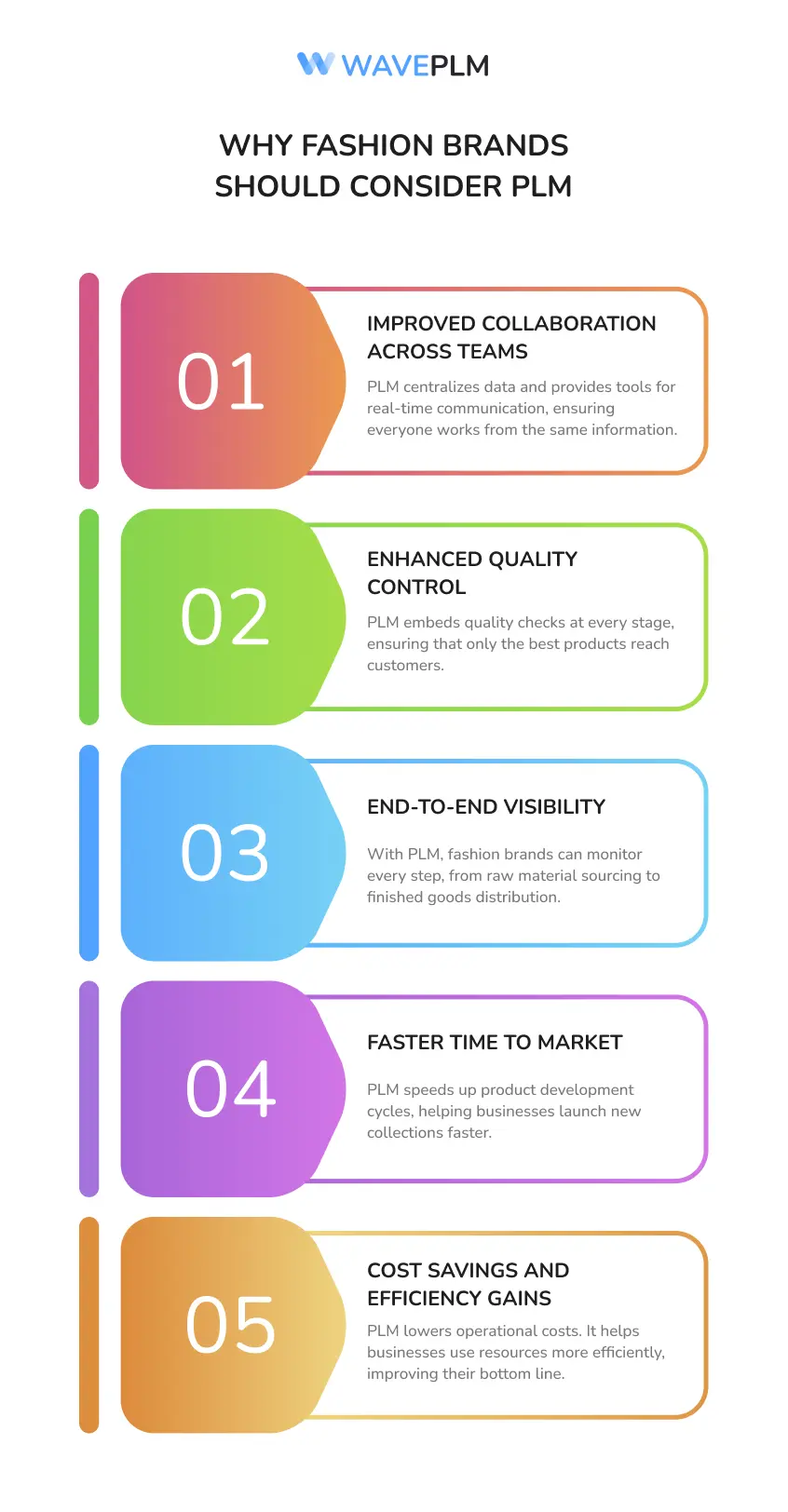
When Standalone Inventory Management Software Makes Sense
While PLM offers many benefits, it’s not the best fit for every business. In some cases, standalone inventory management software may be a better choice.
1. For Small Businesses and Startups
Small businesses with simpler operations often benefit from inventory systems. These tools are straightforward and focus on essential tasks like stock control and purchase orders. They provide the necessary features without the complexity of PLM.
2. For Businesses Focused Solely on Stock Management
If your main concern is managing inventory levels and syncing with POS systems, standalone inventory software is sufficient. It provides the tools needed to track stock and fulfill orders efficiently.
3. For Companies Not Ready for Full Integration
PLM integrates multiple business processes, which can be overwhelming for smaller companies or those not ready for such a comprehensive solution. In these cases, starting with inventory management software makes sense.
Choosing the Right Solution
Selecting the right software depends on your business needs and goals. Consider the following factors when making your decision:
- Business Size: Smaller businesses may find standalone inventory management tools sufficient. Larger companies or those planning to grow will benefit more from PLM’s scalability.
- Supply Chain Complexity: The more complex your supply chain, the more you’ll need an integrated solution like PLM.
- Growth Plans: If you plan to expand your product line or enter new markets, PLM can help you scale operations effectively.
- Customer Expectations: PLM enables faster product launches and better quality control, helping you meet customer demands more effectively.
The Benefits of an Integrated Approach
For many fashion brands, combining the strengths of both systems offers the best results. By integrating inventory management with PLM, businesses can optimize their entire supply chain.
This integrated approach provides:
- Real-time inventory tracking
- Seamless collaboration across teams
- Faster product development cycles
- Improved quality control
- Scalability to support business growth
By aligning all aspects of the product lifecycle, businesses can improve efficiency, reduce costs, and deliver better products to their customers.
Conclusion
PLM and standalone inventory management software serve different purposes. Inventory software focuses on stock control, making it ideal for small businesses or those with straightforward supply chains.
PLM, on the other hand, offers a comprehensive solution that manages the entire product lifecycle. It’s perfect for fashion brands looking to streamline operations, improve quality, and scale their business.
Choosing the right system depends on your business’s unique needs. For many fashion brands, PLM provides the tools needed to thrive in a competitive market, ensuring they stay ahead of trends and meet customer demand efficiently.



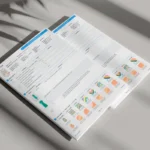

Leave a Reply